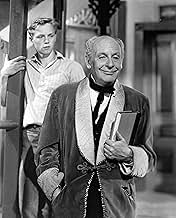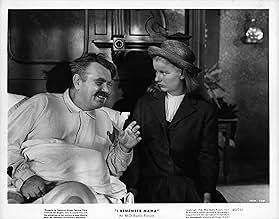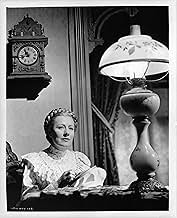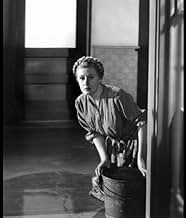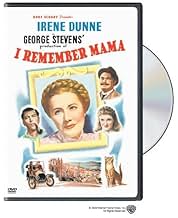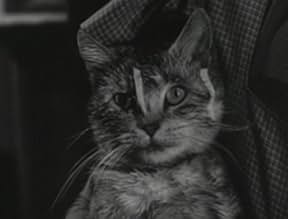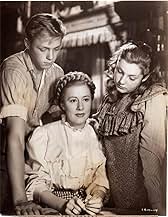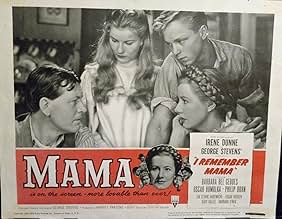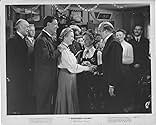A young writer recalls her ups and downs of growing up as one of four children to Norwegian immigrant parents in 1910s San Francisco.A young writer recalls her ups and downs of growing up as one of four children to Norwegian immigrant parents in 1910s San Francisco.A young writer recalls her ups and downs of growing up as one of four children to Norwegian immigrant parents in 1910s San Francisco.
- Director
- Writers
- Stars
- Nominated for 5 Oscars
- 4 wins & 9 nominations total
- Mr. Jonahan Hyde
- (as Sir Cedric Hardwicke)
- Christine Hanson
- (as Peggy McIntyre)
- Minister
- (uncredited)
- Postman
- (uncredited)
- Director
- Writers
- All cast & crew
- Production, box office & more at IMDbPro
Featured reviews
This is a profound movie - and not because every character is so good or lovable (as I expected). They aren't. However, it has so many truthful moments about families, so much warmth - and so much is going on at any given time that your interest is held very strongly. I was amazed to find tears coming down my face - that just doesn't happen when I watch movies. You're bound to be thinking of your own family growing up.
I can see why the book was celebrated, the play ran forever and this movie was nominated for so many awards. There's no question the play would run forever today - it contains too many moments of truth about family relations for people not to be telling their friends "It's really good - really".
Do see it - it's WAY better than you think - you'll be very moved.
Every Saturday morning Mama's ritual would be to corral her family around the kitchen table and distribute Papa's weekly pay amongst the most critical bills that they had to pay such as their rent to their landlord, groceries, the children's clothing needs and education for books and writing material. Every week Mama would comment "Good we have enough money this week so there is no need to have to touch our bank account". Mama and Papa also retained what they called their "little bank" which held a few coins in a metal tin which periodically they would need to resort to in an effort to make ends meet each week.
Anyone who lived through the baby boomer years of the 1940's – through the 1960's would understand that "getting by through compromise and doing without" was a way of life whereas children of today call it "get it, buy it, and pay for it later". Mrs. Shullivan and I thoroughly enjoyed this films story which was narrated by the Hansen's eldest daughter Katrin, played by Barbara Bel Geddes. Of course this was a simpler time in the early 1900's and one of the great Directors of all time George Stevens, stuck to the script and allowed his audience to enjoy a simpler time in American history and the daily living rituals of an immigrant Norwegian family that extended to three Aunts (Jenny, Sigrid and spinster Trina played by Ellen Corby) and one gruff Uncle Kris (played superbly by Oskar Homolka) who was both feared and respected.
The four children loved their parents immensely and although they suffered financially through hard times their strength was in the extended family unit comprised of the Hansen's three Aunts, one young cousin, and one gruff Uncle Kris who owned his own car and who had a female companion who was a mystery woman which was reflected by the family always wondering if she was Uncle Kris's housemaid or his wife? Of course the Hansen's needed to take on a boarder (my own family had two boarders in the 1950's) who always committed to paying his board the following week. In lieu of payment the boarder Mr. Hyde (played by Cedric Hardwicke) would read classic novels out loud to the family each night with so much passion and emotion that it inspired the eldest daughter Katrin (played by Barbara Bel Geddes) to want to become an author herself.
Throughout the film we see the families reliance on Mama Hansen to provide strength, a positive attitude and most especially hope to the Hansen clan. Near the end we come to realize that Mama was telling a white lie to her children, and if you have not shed a tear or two by this point in the film then I can only assume you were born after year 2000 when hardship is an unknown term to many. Mrs. Shullivan and I truly loved this film and directors such as George Stevens who directed I remember Mama rank right up there with the very best directors such as Frank Capra, John Ford, and George Cukor.
If you want to see a film that allows you to reminisce about your own childhood and relationship with your extended family then this film will be sure to bring back some of your old memories to the forefront with the narration by then 26 year old actress Barbara Bel Geddes who explains her upbringing and the loving relationship she shared with her siblings, her father, and most importantly her Mama played with such love and thoughtfulness as only actress Irene Dunne could have accomplished. Be prepared to shed a few tears. I rated it a strong 8 out of 10 for director George Steven's unique ability to take the simplest of story lines, that being an early 1900's immigrant families daily struggles that are conquered through the family bond.
This is perhaps not so surprising when we look a bit more closely at the people involved here. It's true, Bodeen's scripts for the Val Lewton horrors were deeply disturbing and filled with uncomfortable psychological insights, but they were also very humane and sympathetic towards villains and victims alike – something you don't often get in the genre. They were also very carefully balanced, with a real understanding of structure. You can see that understanding in I Remember Mama, particularly in the way it uses comedy. Funny moments dovetail into sad ones and vice versa, which gives more weight to the poignant scenes and stops them becoming mawkish.
The cinematography of Musuraca once gave those RKO B-horrors their distinctive look – much of the screen shrouded in mysterious darkness, with key elements picked out in stark white. With I Remember Mama (for which he received his only Oscar nomination) he actually does something quite similar, albeit for very different effect. In interior shots he makes the backgrounds rather indistinct, while the actors are sharp and clear. This encourages us not to focus on the humbleness of the location, but on the people within it. However there are points of brightness on the home set where most of the story takes place, from windows or plates, which gives depth and character to the place when it is needed. In fact, this whole set is a lovely design – each room is very small, but there seem to be numerous doors and stairways coming off room, giving a feeling of cosiness without confinement.
At first glance, I Remember Mama is an anomaly in the post-war career of director George Stevens. With a few exceptions, all his pictures before he did war service in Europe were comedies, and all his pictures after the war are not except this one. However, while there is a lot of humour in I Remember Mama, and Stevens no doubt realised the importance of it, it all comes from Bodeen's screenplay (and John van Druten's stage play). It is not the style of rigorously timed physical comedy that Stevens used to personally build into his pictures, such as the breakfast routine in Woman of the Year.
But there are other ways in which Stevens has changed. He has become a little more subtle and relaxed. His earlier pictures contain a lot of camera movement and very intense close-ups. Now he often calmly keeps the camera back, showing the characters moving around their environment. He is very much concerned with movement within the frame, such as a swinging pendulum that gives a soothing quality to the image. Perhaps the best example is in the hospital when Irene Dunne visits Dagmar in the night. Rather than closing in and making the moment just about mother and daughter, Stevens expresses it through the entire room, with a billowing curtain in one corner keeping a tiny bit of movement going, and here and there children sitting up to listen, really capturing the tenderness and intimacy.
Of course much of the charm of this picture comes not from how it is written or shot, but from who is in it. At the centre of things is a typically understanding and believable performance from Irene Dunne, perhaps the greatest actress never to win an Academy Award. She is supported by steady turns from Philip Dorn and Barbara Bel Geddes. However, the most truly excellent contributions are those of Edgar Bergen, Ellen Corby and, of course, Oskar Homolka. It is the impeccable timing and rapport between these three that make that all-important comedy element work.
I have mostly looked at this picture from the point of its being at odds to the careers of its creators, and some might say this is missing the point. After all, it simply goes to show that truly creative people are versatile. Still, it fascinates me that all that darkness and pessimism of RKO in the 1940s could still give us something as stirring and beautiful as I Remember Mama.
Irene Dunne heads up a fine cast, and she gives one of her many quality performances as "Mama". The supporting cast are all good as well, and they complement each other nicely. Oskar Homolka is especially worthy of note as Uncle Chris, the kind of character who seems to be found in so many families. The portrayals of the characters and the selection of situations in their lives are both so good that you feel very much a part of things, almost from the beginning.
Everything is nicely conceived and carefully crafted, and it is also a good example of the ideal way to adapt written material for the screen. Without adhering strictly to the original, it captures the feel and the themes of the original stories, showing with talking pictures what Kathryn Forbes had said so well with words.
Both the material itself and the style of the adaptation are delightful, and this is the kind of movie that takes much more skill to produce than may seem to be the case. While this kind of thoughtful, deliberately-paced film has unfortunately gone out of style at the present time, "I Remember Mama" is enduring, enjoyable, and worthwhile.
Did you know
- TriviaIrene Dunne worked with dialect coach Judith Sater for two months to perfect her Norwegian accent. Dunne became so immersed in getting her character's voice down that she used the accent around her home with her family.
- GoofsIn the shots of the uncle's trip to San Francisco, as the ferry is pulling into the dock, the Oakland Bay Bridge is seen in the background. This bridge was not built until 1933, yet this movie is set circa 1910.
- Quotes
Katrin Hanson: [reading the novel that she's just finished] "For long as I could remember, the house on the Larkin Street Hill had been home. Papa and Mama had both born in Norway but they came to San Francisco because Mama's sisters were here, all of us were born here. Nels, the oldest and the only boy, my sister Christine and the littlest sister Dagmar but first and foremost I remember Mama".
- ConnectionsEdited into The Waltons: The Awakening (1974)
- How long is I Remember Mama?Powered by Alexa
Details
Box office
- Budget
- $3,068,000 (estimated)
- Runtime2 hours 14 minutes
- Color
- Aspect ratio
- 1.37 : 1
Contribute to this page





